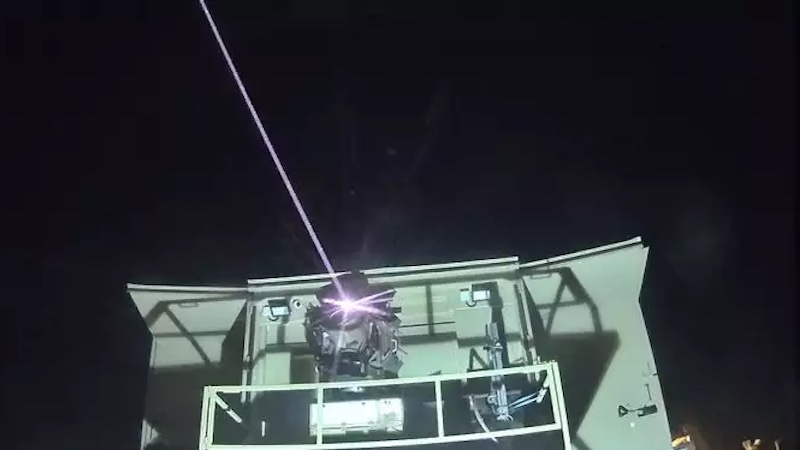Beyond Missiles: Could Israel’s Laser Weapons Rewrite Rules Of Air Defense? – Analysis

Israel’s advanced Iron Beam high-energy laser weapon system will not be operational ahead of schedule, even with the growing threat of a full-scale war with Hezbollah on its northern border with Lebanon. Israel’s Defense Ministry and industries are working hard to speed up deployment of the Iron Beam, but the earliest this unique air defence system will be ready is still end-2025. This timeline has been set for a while, according to Newsweek.
Gideon Weiss, head of international marketing and business development for Israel’s state-owned Rafael Advanced Defense Systems, said the timeline for the Iron Beam remained unchanged since October. According to Newsweek, it is still expected to be operational by next year-end. Israel’s Defense Ministry told the news outlet that the government and Israeli industries were doing their “best to speed up any resolutions for the current conflict, tailored to combat needs and battlefield conditions.”
Israel, now almost nine months into an all-out war in Gaza after Hamas’s surprise attacks on October 7, is also facing pressure from Hezbollah, which is advancing from southern Lebanon into Israel’s northern towns and villages. The Tehran-backed group has stated it is launching drones, rockets and missiles into northern Israel to support Hamas after Israel vowed to eliminate the latter from the Gaza Strip.
Iran’s mission to the United Nations has warned of a “obliterating or a destructive war” if Israel starts any operations in Lebanon.
Israeli officials say their forces are finishing operations in Gaza and are now focusing more on the Lebanese border. Israel’s military has approved provisional plans for a full-scale ground offensive against Hezbollah in southern Lebanon.
However, US officials told CNN that Washington was deeply concerned that Israel’s air defences in the north could be overpowered if a full-scale war breaks out with Hezbollah. Extra air defence systems that can shoot down Hezbollah’s drones and mortars could give Israel more protection if its current air defences cannot handle the threat.
A spokesperson said the Iron Beam system was being developed quickly, and soon it could be deployed would depend on the testing and development stages. They are working as fast and as efficiently as possible to provide operational solutions for forces in the field.
Iron Beam Weapons System
The Iron Beam uses laser technology to cut through airborne targets, such as drones. According to Rafael, the main contractor for the system, it can intercept threats from several miles away. The Iron Beam is meant to integrate into the current air defence network—not replace existing systems. These systems include Israel’s well-known Iron Dome, the long-range David’s Sling and Arrow 3.
The Israel Defense Forces (IDF) reported that these systems successfully intercepted an incoming target for the first time in November. The systems cover different ranges and are designed to counter various threats—from short-range rockets fired by Hamas to long-range ballistic missiles from Iran. A defence ministry spokesperson said that Israel’s multi-layer air defence system was a “major national asset” and was “crucial for defending against any threat, including those from the north”.
A spokesperson for Rafael told Newsweek that over 2,000 of its employees were called up for emergency reserve duty after Hamas’s October 7 attacks and hundreds of staff members were evacuated from their homes. They mentioned that such systems as the Iron Beam would be deployed when they could effectively meet operational needs.
It would complement the Iron Dome’s Tamir kinetic interceptor missiles—used by the Iron Dome system to physically intercept and destroy incoming threats, such as rockets or missiles, through direct impact—by providing an additional ‘energy-based intercepting capability’. The spokesperson added that the system had been built to counter various threats targeting the Israeli homefront, whether from the north or the south.
Israel stated that tests had demonstrated the Iron Beam could intercept rockets, mortars, anti-tank missiles and drones—threats that militaries worldwide are increasingly addressing. Former Prime Minister Naftali Bennett called it a ‘game-changer’ in 2022, saying that, even though it sounded like science fiction, it was still real.
Other countries, including the UK, are also developing similar systems. Earlier this year, the UK successfully tested its DragonFire laser. Reports from late-2023 claimed the Iron Beam had been used to intercept rockets fired from Gaza. However, an Israeli defence official told Newsweek that these reports were false.
James Black, assistant director of the Defense and Security research group at the RAND Europe think tank told Newsweek that the Iron Beam would not only strengthen Israel’s defences, but also demonstrate the effectiveness of directed energy weapons, positioning Israel as an early adopter of this new technology and potentially allowing it to export to other militaries seeking similar systems.
The US has allocated $1.2 billion to the development of the Iron Beam while also pursuing its own laser projects. The US Army has suggested the possibility of acquiring the Iron Beam if it proves successful.
Bennett has mentioned that each intercept by the system will cost about $3.5, not including the additional expenses incurred to make it operational. Some interceptor missiles in air defence systems can cost several million dollars each. Therefore, a less expensive option for countering low-cost drones or cheaply made rockets is very appealing.
The number of intercepts is also not restricted by the quantity of available missiles. However, laser-based systems are limited by weather conditions and require a direct line of sight to the target.
